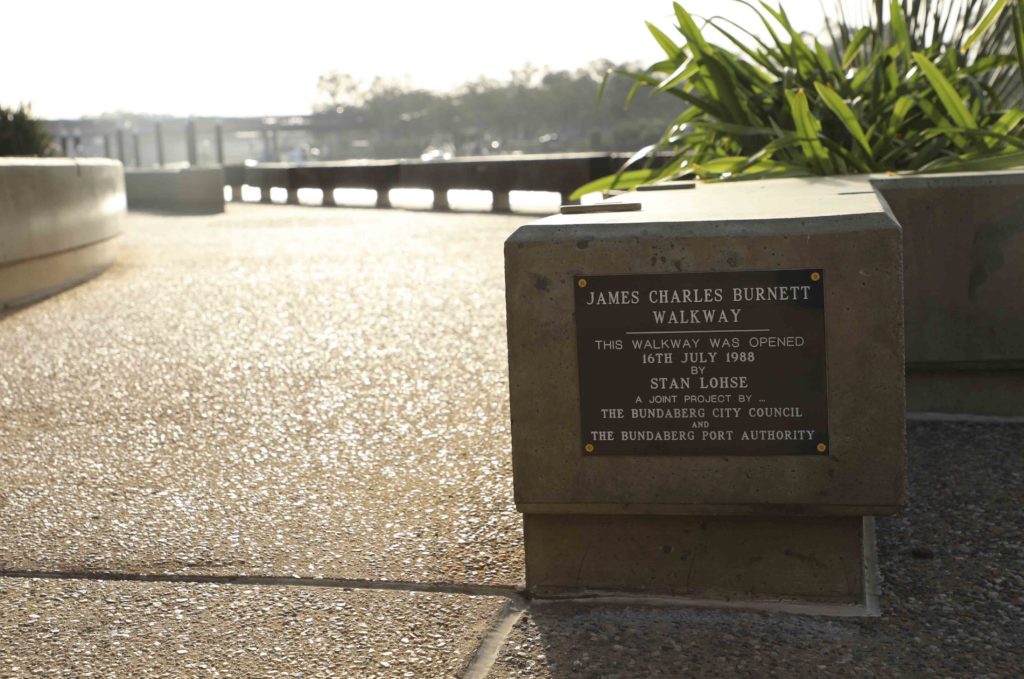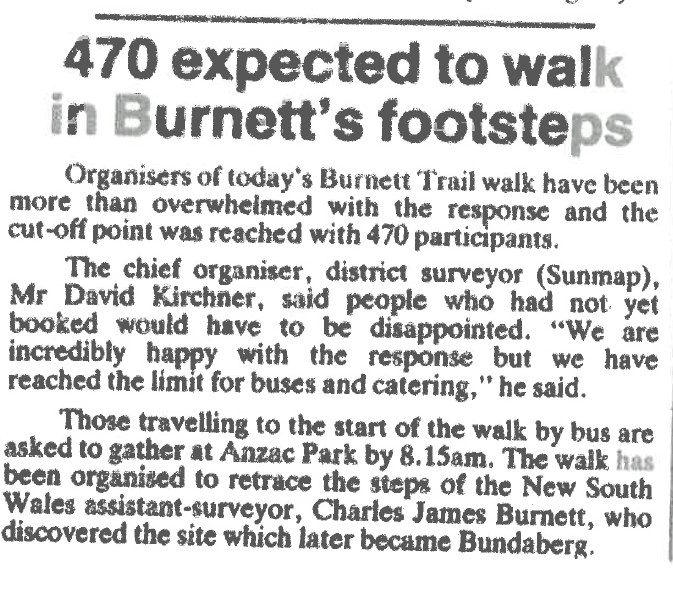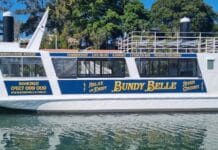
A plaque commemorating Bundaberg’s riverside walkway named in honour of James Charles Burnett, the first government surveyor to enter and map the Bundaberg city area, has been relocated.
The plaque was originally positioned along the riverside walkway near the Bundaberg RSL.
The development of unit blocks in this location was set to obstruct its view which necessitated its relocation to the Midtown Riverside Park.
The opening of the walkway in 1988 was a well-attended occasion, as reported by the Bundaberg NewsMail (18 July 1988, page 1).
“The walkway, which will eventually run from Queens Park to the Rowers Club, was the last section of a long trek undertaken by Assistant-Surveyor James Charles Burnett and his party in 1847,” the article reports.
“… Chairman of the Bundaberg Bicentennial Community Committee, Mr Stan Lohse unveiled a plaque commemorating Burnett before officially opening the first section of the walkway from the river end of Targo Street to the Traffic Bridge.
“Led by the Royal Australian Navy Fleet band, Mr Lohse headed about 500 onlookers for the short walk.”
Neville Rackemann, who submitted a historic piece to the Bundaberg NewsMail on Saturday 16 July (page 10), said the walkway commemoration was a fitting tribute to Burnett.
“Althought [sic] the name Burnett is familiar throughout the district today, except for the Governor of NSW naming our river in his honour, nothing has ever been done over the years to acknowledge Burnett’s work in exploring and surveying the lower reaches of the river.
“By pushing himself to the limit, Burnett paid the price by dying while still a young man.
“Had he lived, it is highly likely that Burnett could have become Australia’s Surveyor-General.”
According to historical articles, during the 1980s it was tradition to mark “Burnett Discovery Day” with an eight kilometre walk retracing the steps that bought Burnett to Bundaberg city on his journey to discover where the Burnett River entered the sea.
Newspaper reports from 1988 said the cut-off point for discovery day walk participants was reached with an impressive 470 walkers.

In his 1988 article, Mr Rackemann said the event was a treat for local history buffs with the year marking 141 years since Burnett’s discovery.
“In 1847, Burnett made two trips to the future site of Bundaberg, one overland and one by sea from Brisbane in a small, open boat.”
On the morning of April 1, 1847 Mr Rackemann wrote that Burnett and his party were camped near scrub adjacent to Tomato Island.
“…for the evening ritual of boiling the billy the surveying party obtained fresh water from McCoy’s Creek.”
The book In the Steps of our Forefathers, by the Institution of Surveyors Australia Queensland Division (1988, p 18) published notes written by Burnett throughout the journey.
“Next morning we followed down the river for about six miles, having gone round the scrub and some small mangrove creeks, when after crossing a swamp, in which I nearly lost my horse, we came to another, too wet even for a man to travel over, and beyond it was a large salt water creek with a dense scrub along its banks,” Burnett wrote.
He was standing at what is now the eastern end of the Bundaberg City area overlooking Saltwater Creek and what would have been dense and difficult to navigate scrub.
Burnett wrote that he was “sufficiently near the coast to be perfectly certain that the outlet of the Boyne was in Hervey Bay, probably at the spot where Flinders noticed two shallow inlets, which he did not examine”.
“Thus James Charles Burnett on 1 April, 1847 became the first white man to stand on the future site of the now thriving city of Bundaberg.”







